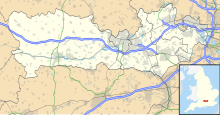Sandhurst to Owlsmoor Bogs and Heaths
| Site of Special Scientific Interest | |
 | |
| Location | Berkshire |
|---|---|
| Grid reference | SU 843 628[1] |
| Coordinates | 51°21′25″N 0°47′20″W / 51.357°N 0.789°W |
| Interest | Biological |
| Area | 85.8 hectares (212 acres)[1] |
| Notification | 1983[1] |
| Location map | Magic Map |
Sandhurst to Owlsmoor Bogs and Heaths is an 85.8-hectare (212-acre) biological Site of Special Scientific Interest (SSSI) on the northern outskirts of Sandhurst in Berkshire.[1][2] Part of the SSSI is Wildmoor Heath nature reserve, which is managed by the Berkshire, Buckinghamshire and Oxfordshire Wildlife Trust.[3] and the SSSI is part of Thames Basin Heaths Special Protection Area.[4]
Geography
Wildmoor Heath is situated on a slope and features wet and dry lowland heath and valley bog, plus pine and broadleaved woodland.[3]
History
In 1975 the site was designated a site of special scientific interest (SSSI).[5] Wildmoor Heath nature reserve was formed in 1998 by combining land at Edgbarrow Woods, Owlsmoor Bog, and Wildmoor Bottom.[6]
Fauna
The site has the following animals:[3][7][5][6][8]
Mammals
Reptiles and amphibians
Birds
- Common chiffchaff
- Great spotted woodpecker
- European green woodpecker
- European nightjar
- Common snipe
- European stonechat
- Willow warbler
- Dartford warbler
- Woodlark
- Eurasian bullfinch
- Eurasian hobby
- Common kingfisher
Invertebrates
- Hairy dragonfly
- Common hawker
- Golden-ringed dragonfly
- Libellula depressa
- Keeled skimmer
- Beautiful demoiselle
- Banded demoiselle
- Lestes sponsa
- Erythromma najas
- Large red damselfly
- Blue-tailed damselfly
- Enallagma cyathigerum
- Azure damselfly
- Southern hawker
- Brown hawker
- Migrant hawker
- Emperor dragonfly
- Downy emerald
- Brilliant emerald
- Black-tailed skimmer
- Four-spotted chaser
- Sympetrum danae
- Ruddy darter
- Common darter
- Silver-studded blue
- Stag beetle
- Raft spider
- bog bush cricket
- Saturniinae
- Argiope bruennichi
Flora
The site has the following flora:[5][7]
Trees
Plants
- Erica tetralix
- Molinia caerulea
- Drosera rotundifolia
- Drosera intermedia
- Rhynchospora alba
- Carex pulicaris
- Narthecium ossifragum
- Pinguicula vulgaris
- Calluna
- Eriophorum angustifolium
- Succisa pratensis
- Scutellaria minor
- Hypericum elodes
- Lychnis flos-cuculi
- Succisa pratensis
References
- ^ a b c d "Designated Sites View: Sandhurst to Owlsmoor Bogs and Heaths". Sites of Special Scientific Interest. Natural England. Retrieved 9 November 2019.
- ^ "Map of Sandhurst to Owlsmoor Bogs and Heaths". Sites of Special Scientific Interest. Natural England. Retrieved 9 November 2019.
- ^ a b c "Wildmoor Heath". Berkshire, Buckinghamshire and Oxfordshire Wildlife Trust. Retrieved 9 November 2019.
- ^ "Designated Sites View: Thames Basin Heaths". Special Protection Areas. Natural England. Archived from the original on 23 November 2018. Retrieved 28 September 2018.
- ^ a b c "Site Name: Sandhurst to Owlsmoor Bogs and Heaths" (PDF). Retrieved 14 April 2017.
- ^ a b "The Dragonflies in Bracknell Forest Borough: Overview for the Period 1993 to 2012" (PDF). John Ward-Smith. Retrieved 14 April 2017.
- ^ a b "Condition of SSSI Units for Site Sandhurst to Owlsmoor Bogs and Heaths SSSI". Natural england. Retrieved 14 April 2017.
- ^ "Wildmoor Heath: Parks to visit - Bracknell Forest Council". Bracknell-forest.gov.uk. Retrieved 14 April 2017.

